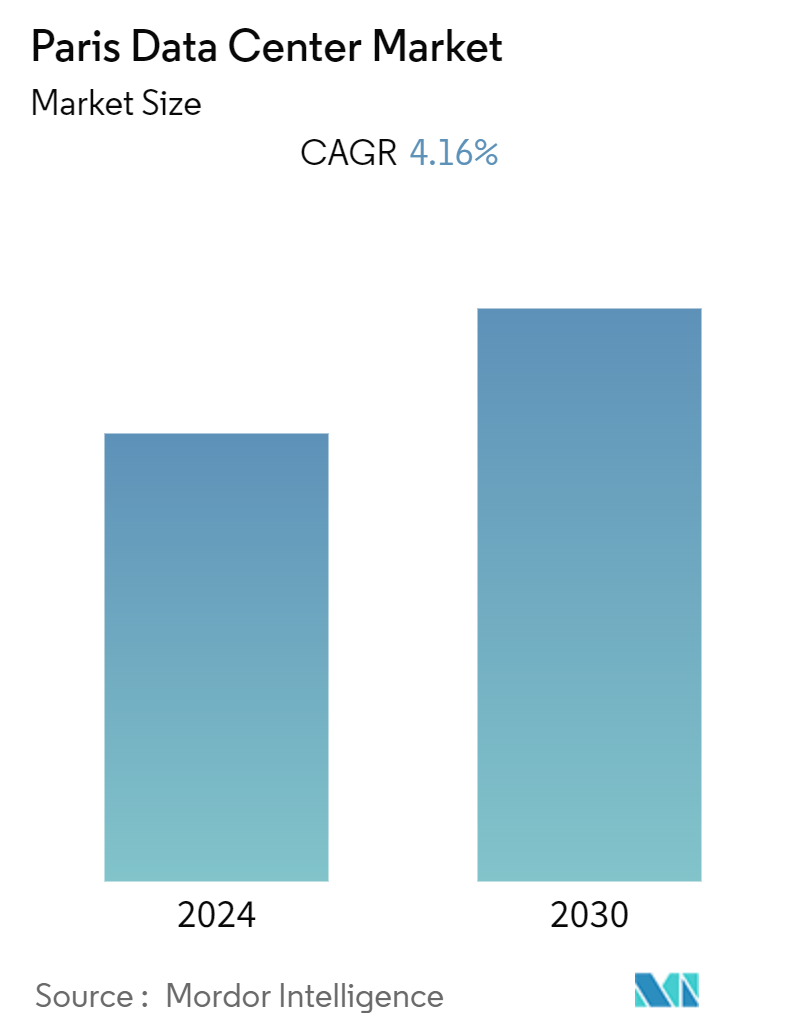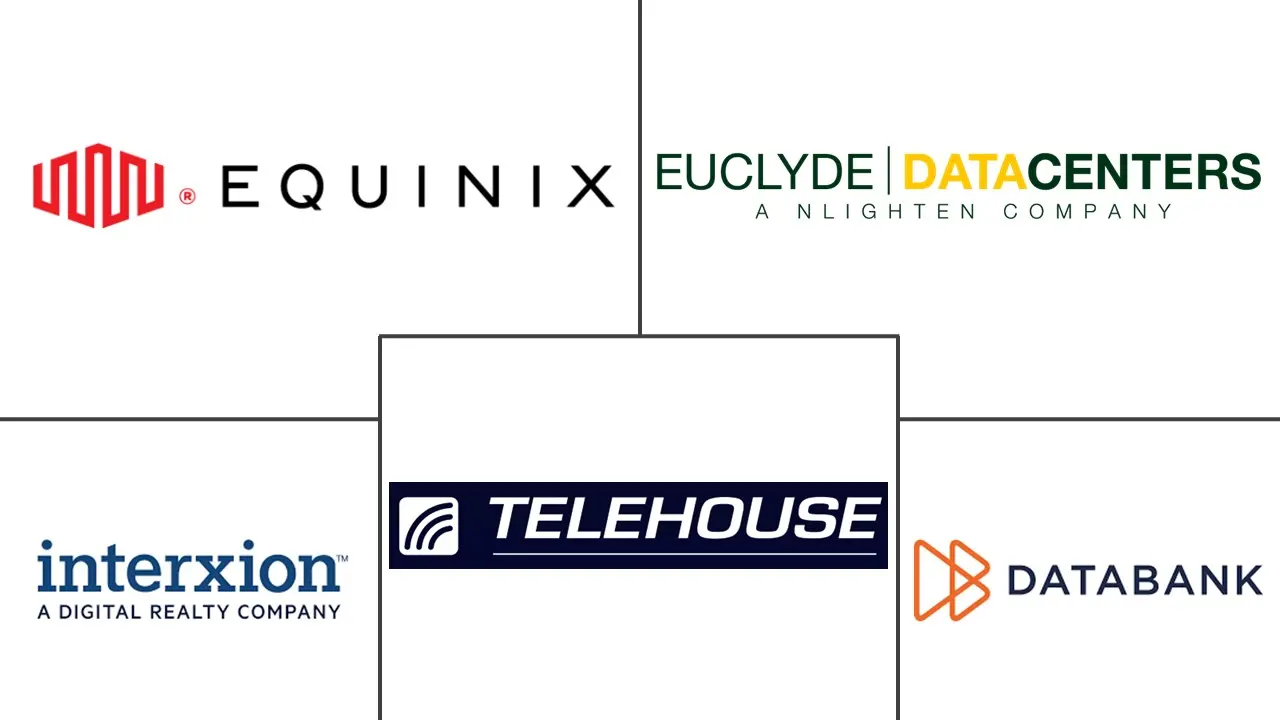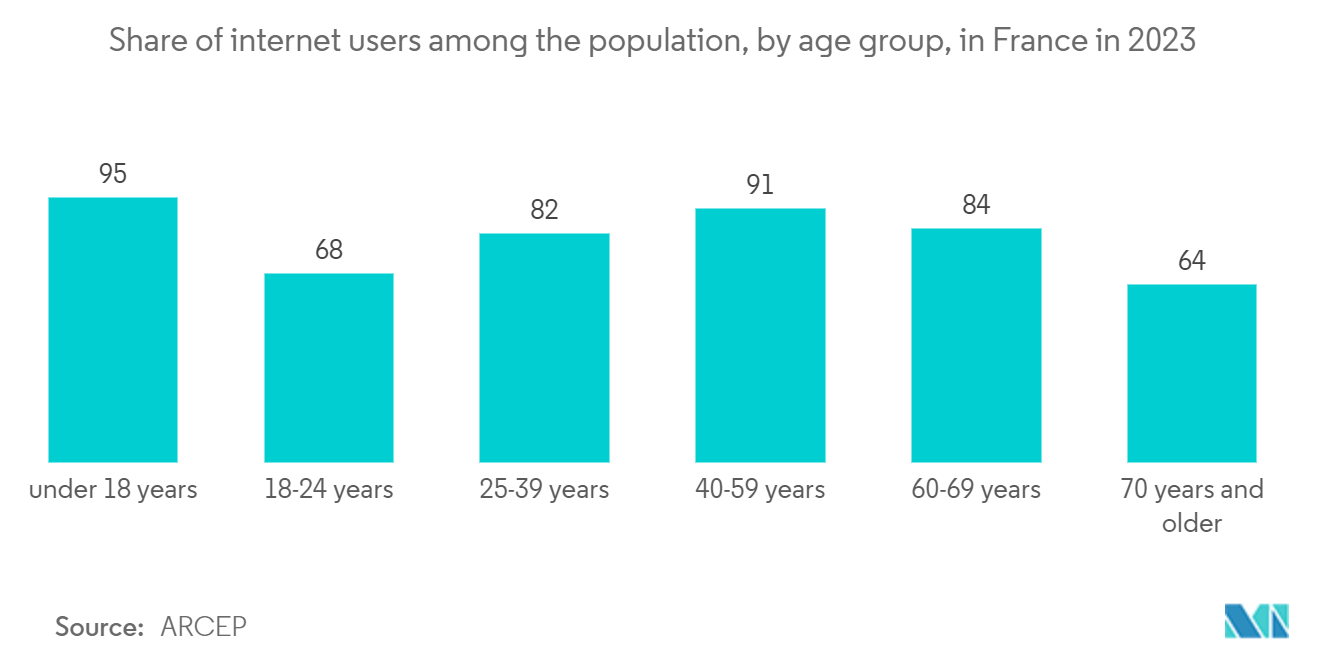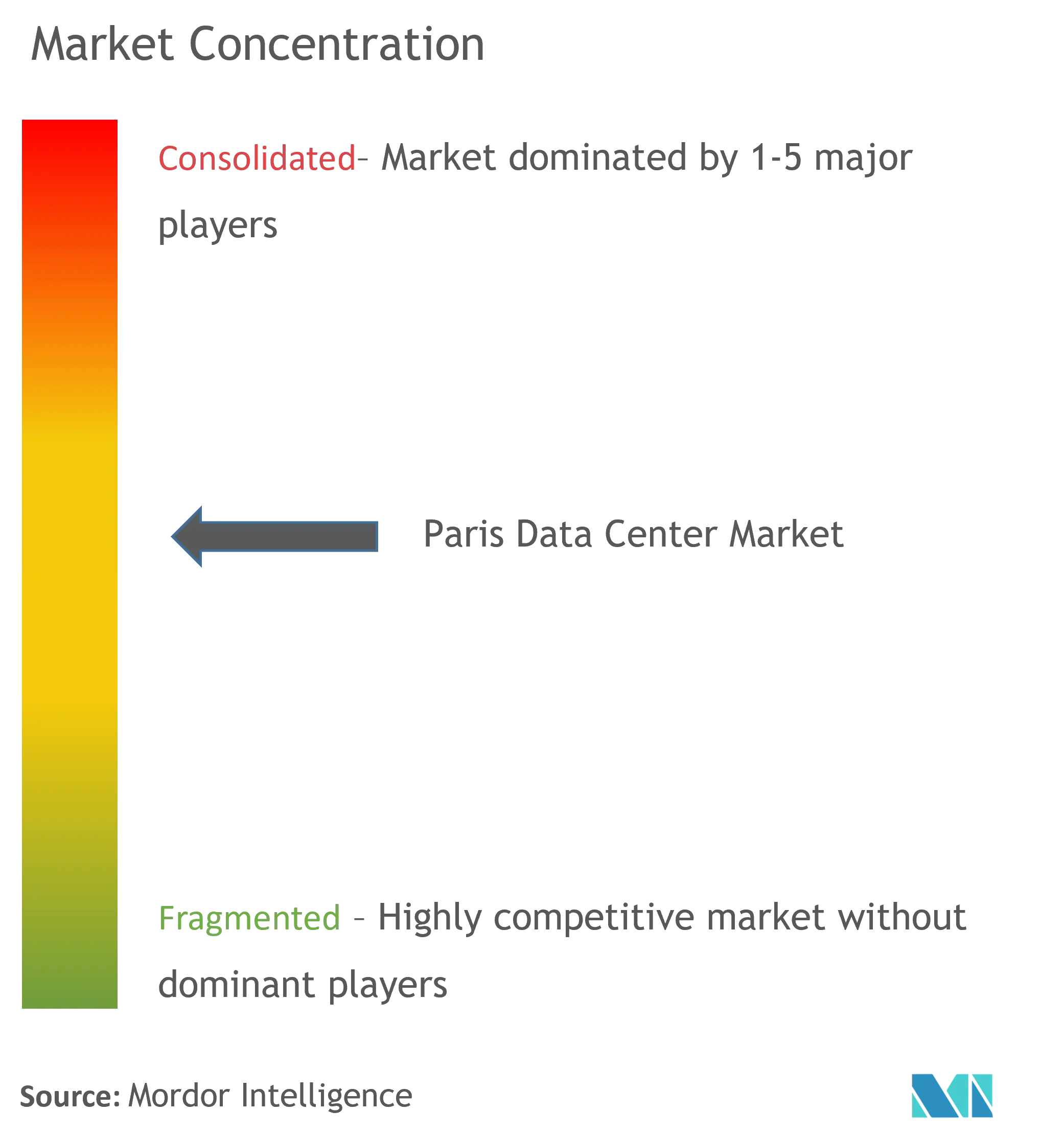Paris Data Center Market Size

| Study Period | 2019 - 2030 |
| Base Year For Estimation | 2023 |
| Forecast Data Period | 2024 - 2030 |
| Historical Data Period | 2019 - 2022 |
| CAGR (2024 - 2030) | 4.16 % |
| Market Concentration | Medium |
Major Players
*Disclaimer: Major Players sorted in no particular order |
Paris Data Center Market Analysis
The Paris Data Center Market is expected to register a CAGR of 4.16% during the forecast period.
The main drivers anticipated to drive the market expansion are the increasing demand for energy-efficient data centers, considerable investment by colocation service and managed service providers, and expanding hyperscale data center building. Additionally, the development of big data, cloud computing, and the Internet of Things (IoT) has made it possible for businesses to invest in new data centers to preserve business continuity.
- Additionally, industrial development is expected to prosper due to the rising need for security, operational efficiency, improved mobility, and bandwidth. Software-based data centers boost industry growth by providing a higher level of automation.
- Artificial intelligence (AI) with machine learning (ML) necessitates the development of brand-new data center infrastructure more than any other application. Artificial intelligence (AI) and machine learning (ML) may require three times the power density of traditional data processing, necessitating a revolution in data center architecture. This is also dependent on sophisticated cooling systems to support the larger output. The intense nature of AI and ML computations may also result in a significant dispersion of computational, memory, and storage resources among many processors in a computational cluster.
- Paris has various artificial intelligence applications, including healthcare, fashion, and sciences. For example, the Radiology Department in Groupe Hospitaller Cochin Broca Hôtel-Dieu - Université Paris Descartes uses artificial intelligence in thoracic imaging and lung cancer applications, such as detecting and segmenting pulmonary nodules. Moreover, at Paris Fashion Week, artificial intelligence machines were used to picture conceptual apparel in a showroom. Such a wide range of AI in various industries would drive the market's demand.
- Moreover, telcos will require more servers and low-latency connectivity alternatives as more individuals spend time online. The size and connectivity of hyperscale data centers will be required to handle rising demand. In 2023, services will continue to be delivered as a single service or set of services using various resources, including networks, devices, private and public cloud services, and cloud deployment and operation platforms. Public clouds have enormous processing capacity, whereas private clouds give more security and control.
- For instance, in June 2022, Oracle announced the launch of a second cloud region in France to provide public cloud services to businesses looking to modernize their operations. In addition to the Oracle Cloud Marseille area, the new La Courneuve, Paris region will provide Oracle's European customers and partners with access to a broad spectrum of cloud services with built-in security, disaster recovery, and industry-leading price performance. Oracle's one-of-a-kind dual-region cloud architecture allows French customers to deploy resilient applications in several geographical regions.
- On the flip side, development centers have conducted extensive research on energy efficiency in data centers, focusing on optimal QoS, efficient utilization of resources, and operation cost reduction. They aim to minimize brown energy utilization by proposing a load-balancing approach utilizing the available green energy. Load balancing is based on available renewable energy and has been installed in multiple data centers. A workload and energy management scheme was introduced to decrease the operational cost of the network and energy costs. Combined cooling, heating, and power (CCHP) systems also can reduce carbon emissions and air pollution and significantly increase resource energy efficiency.
- Moreover, coronavirus had a minimal influence over the Paris data center market as it is an essential infrastructure. Data centers remained open during the coronavirus-related shutdowns as the government deemed the operation and maintenance of data centers as a critical service. However, pricing came under pressure during the pandemic owing to macroeconomic slowdowns due to extended shutdowns and prolonged economic slowdowns in the country caused by the pandemic. The demand for data centers has seen a positive rise, augmented by technology demand growth due to shutdowns. Companies upgrading IT infrastructures to support remote working amid shutdowns may shift workloads to the public and private cloud.
Paris Data Center Market Trends
Tier 1 and 2 Segment Expected to Hold Significant Market Share
- Datacenter tiers are an effective way of characterizing the infrastructure components used in a company's data center. The tier 1 data center has a single power and cooling channel, and there are few redundant backup components. It is predicted to have an uptime of roughly 99.671% (28.8 hours of downtime per year). This solution may be adequate for hosting a small business, website, or blog, but it is unsuitable for a corporation with mission-critical applications.
- For tier 1, the center provides businesses with a dedicated space for IT systems, an Uninterrupted Power Supply (UPS), cooling equipment, and an engine generator to meet basic backup needs in case of system failure. For a small business, Tier I may be the ideal solution. The Tier-1 infrastructure is designed for start-up companies needing a colocation data center. This is the easiest budget-conscious option for the small business. The infrastructure consists of a single uplink, a single path for power, and non-redundant servers.
- A Tier-1 colocation center offers dedicated site infrastructure to enable information technology beyond the confines of an office setting. Tier-1 infrastructure contains a separate location for IT systems, a UPS for filtering power surges and brief outages, dedicated cooling equipment that will not be turned off at the end of normal office hours, and an engine generator to safeguard IT services from extended power outages.
- A Tier II data center, on the other hand, includes a single power and cooling line and some redundant and backup components. It is predicted to have an uptime of roughly 99.741% (22 hours of downtime per year). As a failover, redundancy refers to alternative systems such as power, HVAC, and network that are used temporarily in the event of a disturbance. The continuous operation of IT server hardware and related networking equipment is the cornerstone of redundancy. Tier II data centers are often targeted for SMB (small and medium) sized business clients. Tier II providers are also able to handle more clients. Small business servers typically use this level in the region. There is a massive decline in features from levels III to II.
- Further, according to the innovative city index, Paris has the highest score among the other European cities; Paris has a score of 55 out of 60 in 2022 and stands in 4th position in the innovative global cities. Such developments towards innovations would create an opportunity for the market players to establish their data centers in this city and expand their service portfolio to firms in other cities.

BFSI Expected to Drive the Market
- The BFSI industry has been one of the most influenced by enterprises' digital transformation, allowing for more cost-effective revenues. The rising Paris adoption of mobile phones and high-speed internet has pushed individuals to choose digital banking, which has also integrated robust CRM and cloud technologies to store and analyze data, which is projected to boost market growth.
- The rapid expansion of electronic banking, digital storage, and virtualization in the BFSI sector will likely drive demand for cost-effective and energy-efficient data center solutions. It enables the consistent and reliable availability of IT and digital banking services in a highly protected environment. It can also connect and encrypt all device communications while controlling user access to protect against errors and bad intent.
- Moreover, banks and insurance companies must reinvent themselves due to changing regulations, emerging technology, elevated client expectations, and the entry of disruptive competitors. In the fintech industry, online lending has increased in city demand. Thus, online banking will become more popular each year, and it is expected to increase the demand for resilient, safe, cost-effective, and energy-efficient data center solutions, driving the need for data center construction.
- Furthermore, advances in digitization, such as the introduction of PSD2 and robust e-commerce growth, would likely pave the way for developing of numerous new payment methods. A growing range of payment methods, including Apple Pay, Google Pay, RatePAY, Amazon Pay, and many more expected to boost the rise of digital payments. This is predicted to generate a massive amount of data, increasing the demand for cloud adoption and, in turn, increasing the need for data center building around the city.
- The digital ecosystem surrounding a bank is exploding at a rapid pace. With the constant change in demand of consumers, there has been pressure on the banks to customize the product offerings according to their needs. Secondly, consumers who embrace a mobile lifestyle and socialize on digital platforms expect banks to connect with them on the same media. This is affecting the demand for the construction of data centers in the BFSI sector. According to Culture Banque, Boursorama has the highest number of customers in France, with 3,000,000; such a vast number of customers would increase different kinds of data like KYC, online transactions, and many more, allowing the studied market to grow.

Paris Data Center Industry Overview
The Paris Data Center market is moderately consolidated with the presence of several players like Equinix Inc., Digital Realty (Interxion), Euclyde Data Centers, etc. The companies continuously invest in strategic partnerships and product developments to gain substantial market share.
In April 2023, Data4 was planning a new data center complex in Nozay, Essone, southwest of Paris. The PAR3 facility will be developed on a 22-hectare land, previously the head office of Nokia's French headquarters. The corporation has revealed intentions to build eight data centers on the site with a EUR 1 billion investment by 2030. The overall area will be 32,000 square meters, with a capacity of 120 MW. Like many new data center projects, the location will be connected to a local district heating infrastructure.
In October 2022, Telehouse began building a second data center at its TH3 Paris Magny facility. This new data center will have 12,000 square meters of IT floor space and will utilize 18MW of power. Telehouse claims it will benefit from the greatest levels of security and resilience and 99.999% guaranteed uptime. According to Telehouse, the entire investment plan is EUR 1 billion over five years, with EUR 50 million going toward the campus's new TH3 Paris Magny data center, which is set to launch in October 2023.
Paris Data Center Market Leaders
-
Equinix Inc.
-
Digital Realty (Interxion)
-
Euclyde Data Centers
-
Telehouse
-
Databank
*Disclaimer: Major Players sorted in no particular order

Paris Data Center Market News
- May 2023: Digital Realty, a provider of cloud- and carrier-neutral data center, colocation, and interconnection solutions, expanded its customer service offering by adding a new high-performance computing (HPC)-capable data center in Paris. Companies are dealing with a substantial flood of data that needs to be processed at high speeds due to the rising adoption of complex, data-driven technologies such as artificial intelligence (AI) and data analytics, known as data gravity.
- Aug 2022: Colt planned to broaden its France data center near Paris. The business announced a greater than 50% expansion of its Colt Paris South West Data Centre. Colt DCS is rapidly increasing its hyperscale data center footprint in the metropolitan area of Paris to service the city's quickly developing technological population. This site is being expanded further to accommodate one of the firm's worldwide SaaS customer requirements with an additional 12.8MW, having previously provided 20MW of IT power across a gross site size of 5,000 sqm (53,800 sq ft).
Paris Data Center Market Report - Table of Contents
1. INTRODUCTION
- 1.1 Study Assumptions and Market Definition
- 1.2 Scope of the Study
2. RESEARCH METHODOLOGY
3. EXECUTIVE SUMMARY
4. KEY INDUSTRY TRENDS
- 4.1 Smartphone Users
- 4.2 Data Traffic per Smartphone
- 4.3 Mobile Data Speed
- 4.4 Broadband Data Speed
- 4.5 Regulatory Framework
- 4.6 Value Chain Analysis
5. MARKET OUTLOOK
- 5.1 IT Load Capacity
- 5.2 Raised Floor Space
- 5.3 Number of Racks
6. MARKET SEGMENTATION
-
6.1 DC Size
- 6.1.1 Small
- 6.1.2 Medium
- 6.1.3 Large
- 6.1.4 Massive
- 6.1.5 Mega
-
6.2 Tier Type
- 6.2.1 Tier 1 & 2
- 6.2.2 Tier 3
- 6.2.3 Tier 4
-
6.3 Absorption
- 6.3.1 Utilized
- 6.3.1.1 Colocation Type
- 6.3.1.1.1 Retail
- 6.3.1.1.2 Wholesale
- 6.3.1.1.3 Hyperscale
- 6.3.1.2 End User
- 6.3.1.2.1 Cloud & IT
- 6.3.1.2.2 Telecom
- 6.3.1.2.3 Media & Entertainment
- 6.3.1.2.4 Government
- 6.3.1.2.5 BFSI
- 6.3.1.2.6 Manufacturing
- 6.3.1.2.7 E-Commerce
- 6.3.1.2.8 Other End User
- 6.3.2 Non-Utilized
7. COMPETITVE LANDSCAPE
-
7.1 Company Profiles*
- 7.1.1 Equinix Inc.
- 7.1.2 Digital Realty (Interxion)
- 7.1.3 Euclyde Data Centers
- 7.1.4 Telehouse
- 7.1.5 Databank
- 7.1.6 Scaleway Datacenter
- 7.1.7 CyrusOne
- 7.1.8 Cogent Communications
- 7.1.9 Data4 Group
- 7.1.10 Global Switch
- 7.1.11 Colt DCS
- 7.1.12 EXA Infrastructure
- 7.2 Market share analysis (In terms of MW)
- 7.3 List of Companies
Paris Data Center Industry Segmentation
A data center is a physical room, building, or facility that holds IT infrastructure used to construct, run, and provide applications and services and store and manage the data connected with those applications and services.
The Paris data center market is segmented by DC size (small, medium, large, massive, mega), tier type (tier 1 and 2, tier 3, and tier 4), absorption (utilized (colocation type (retail, wholescale, and hyperscale), end user (cloud and IT, telecom, media and entertainment, government, BFSI, manufacturing, and e-Commerce)), and non-utilized). The market sizes and forecasts are provided in terms of value (MW) for all the above segments.
| DC Size | Small | ||
| Medium | |||
| Large | |||
| Massive | |||
| Mega | |||
| Tier Type | Tier 1 & 2 | ||
| Tier 3 | |||
| Tier 4 | |||
| Absorption | Utilized | Colocation Type | Retail |
| Wholesale | |||
| Hyperscale | |||
| Absorption | Utilized | End User | Cloud & IT |
| Telecom | |||
| Media & Entertainment | |||
| Government | |||
| BFSI | |||
| Manufacturing | |||
| E-Commerce | |||
| Other End User | |||
| Absorption | Non-Utilized |
Paris Data Center Market Research Faqs
What is the current Paris Data Center Market size?
The Paris Data Center Market is projected to register a CAGR of 4.16% during the forecast period (2024-2030)
Who are the key players in Paris Data Center Market?
Equinix Inc., Digital Realty (Interxion), Euclyde Data Centers, Telehouse and Databank are the major companies operating in the Paris Data Center Market.
What years does this Paris Data Center Market cover?
The report covers the Paris Data Center Market historical market size for years: 2019, 2020, 2021, 2022 and 2023. The report also forecasts the Paris Data Center Market size for years: 2024, 2025, 2026, 2027, 2028, 2029 and 2030.
Paris Data Center Industry Report
Statistics for the 2024 Paris Data Center market share, size and revenue growth rate, created by Mordor Intelligence™ Industry Reports. Paris Data Center analysis includes a market forecast outlook to for 2024 to 2030 and historical overview. Get a sample of this industry analysis as a free report PDF download.



